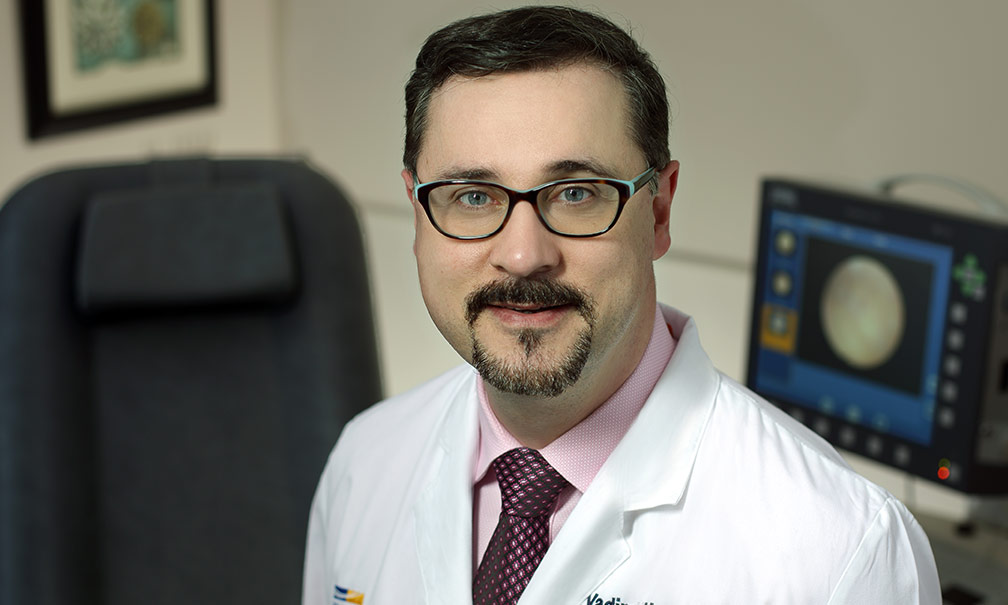Find care now
If you are experiencing a medical emergency, please call 911 or seek care at an emergency room.

In most women, the endometrium—the mucous membrane lining the uterus—grows inside the uterus and sheds during the monthly period. But in women with endometriosis, the endometrium starts to grow outside the uterus, on the surface of the bladder and intestines and all around the pelvic organs.
As a result, women with endometriosis experience symptoms that can range in severity from hardly noticeable to debilitating pain. Common symptoms include:
- Constant dull to severe pelvic pain from inflammation
- Cramping
- Digestive problems, such as diarrhea or nausea
- Heavy menstrual periods
- Pain during sex
- Painful urination
- Subfertility, or difficulty becoming pregnant
Fortunately, treatment is available to reduce these life-altering symptoms. Let’s discuss common questions women ask about endometriosis and how medical advances are changing the way we approach diagnosis.
LISTEN: Dr. Morozov discusses endometriosis treatment in the Medical Intel podcast.
How is endometriosis diagnosed?
We can make an initial diagnosis by listening to a patient describe her symptoms and by conducting a physical exam. But to be 100 percent sure, we must perform minimally invasive surgery and do a biopsy of any endometrial lesions, or tissues that have been damaged by the culprit disease.
The cause of endometriosis is unknown, but we know genetics can play a role. For example, if a woman’s mother, sister, or aunt had endometriosis, she is at a higher risk of developing it herself. Some studies also claim that environmental factors, such as organic pollutants in the atmosphere, also affect the development of endometriosis. However, we do not yet have conclusive results.
How is endometriosis treated?
Endometriosis is very unlikely to go away on its own. Thankfully, treatment can radically reduce symptoms for many patients. We typically start with medications, such as non-steroidal anti-inflammatory drugs (NSAIDs) like ibuprofen, or birth control pills that control hormonal fluctuations in the body. However, most patients don’t find enough relief with medication alone and eventually opt for minimally invasive surgery to remove the endometriosis. This procedure is performed through incisions in the belly that are less than an inch in length.
It’s important to seek treatment for endometriosis as soon as you notice symptoms. That way, we can work to control the endometriosis before it can spread to other organs in the pelvis and abdomen. Additionally, the symptom of pelvic inflammation has led researchers to speculate that there could be an association between endometriosis and endometrioid-type ovarian cancer, or when endometrioid tumors develop in the ovaries. There is no direct link, but some researchers are studying whether particular endometriomas— ovarian cysts containing thick, brown fluid—could lead to endometrioid-type cancer.
What is recovery like after endometriosis surgery?
Patients usually feel substantial symptom relief within six months after surgery. During the first six to eight weeks, patients might be sore from the procedure. Then, the endometriosis pain starts to dwindle. The severity of pain during recovery varies from patient to patient.
I have an honest discussion with my patients in anticipation of the treatment option she chooses. It’s important to note that the goal of surgery or medication can’t realistically be to make a woman 100 percent pain-free, but to control her symptoms so she can function normally with minimal pain.
You tell us: Have you undergone successful endometriosis treatment? Tell us about your experience on Twitter or Facebook.
What advancements can improve treatment in the future?
There are a couple exciting areas of research regarding endometriosis right now. One is the development of biological markers for the disease, which would allow doctors to diagnosis it without doing surgery. The markers are made by drawing patients’ blood or doing a saliva test. The tests would go to a laboratory and determine whether there’s a good chance someone has the disease. It’s still in the research phase, but the results so far are promising.
Other research includes the development of better visualization tools for surgery. We often go into laparoscopy with a small camera that’s placed in the abdomen and pelvis, and there is a risk that we might miss a lesion because our eyes alone can’t always recognize them in the pelvis. As a result, researchers are working on camera filters that allow for better visualization during laparoscopic surgery.
MedStar Washington Hospital Center is one of the largest and best equipped medical facilities on the east coast. Our group at the National Center for Advanced Pelvic Surgery has multiple urogynecologists and specifically-trained female urologists that specialize solely in endometriosis and chronic pelvic pain.
If you experience endometriosis symptoms, don’t wait to seek treatment. Our endometriosis specialists offer initial diagnosis, second opinions and ongoing care for chronic pelvic pain.














